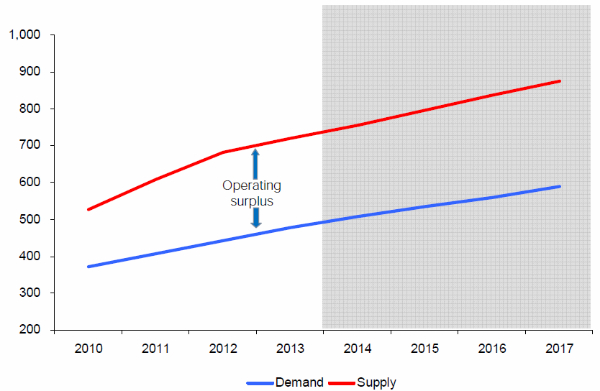How will lower bunker prices affect the substantial overcapacity in dry bulk market?
As bunker fuel costs have come down from USD 600 per tonnes to USD 330 per tonnes in the past 6 months, much talk about increased ship speed have surfaced.
Some single-voyage or single company estimations aims at supporting reintroduction of higher speed to generate higher revenue and potentially higher earnings. In reality, some of them may actually prove to deliver on the promise too.
However, as Chief Shipping Analyst at BIMCO, Peter Sand, said:
“When you consider the entire dry bulk fleet on a global scale, overcapacity remains substantial. In that sense, there is no overall case for increasing speed anytime soon.
“BIMCO concur to the estimates made by Dreary, which point to an operating surplus of some 25% in the market today.”

Source: Drewry Maritime Research
Bear in mind that as long as the demand side and the supply side continues to match one another quite narrowly, the operation surplus will stay put. We need several years of strong demand growth and low supply growth in order to reduce the overcapacity substantially.
This is why is remains important for industry profitability to make sure slow steaming continues to be an integrated part of business conduct.
Slow steaming
In spite of bunker fuel costs coming down significantly, it remains by far the largest cost item for owners and operators. The hefty fuel bills, seen during the past couple of years, may have been paused for a while, but may also prove sticky as the oil price futures all present a steep counting (Canting is a situation where the futures price (or forward price) of a commodity is higher than the expected spot price).
“Bringing higher ship speed back may cause some unwanted commotion to the freight market, where the norm in recent years has been one of lower and lower ship speed.
“Lower ship speed has significantly assisted freight rates in staying higher than they would in the case of all ships steaming at full ahead. Reversing this trend may also mean reversing the benefits obtained from slow steaming”, adds Peter Sand.
HEADLINES
- Do shipping markets want Biden or Trump for the win?
- All 18 crew safe after fire on Japanese-owned tanker off Singapore
- Singapore launching $44m co-investment initiative for maritime tech start-ups
- Cosco debuts Global Shipping Industry Chain Cooperation Initiative
- US warns of more shipping sanctions
- China continues seaport consolidation as Dalian offer goes unconditional